Abstract
This paper presents an experimental acoustic noise characterization of a switched reluctance motor (SRM) designed for a wind turbine pitch angle control application. It details the fixture design for holding and positioning the sound intensity probes, along with the essential hardware setup for conducting acoustic noise experiments. Additionally, the software configuration is described to ensure compliance with specific measurement requirements. To study the effect of speed and load variations on the motor’s acoustic noise characteristics, tests are conducted at various operating points. The tests employ pulse-width modulation (PWM) current control, operating at a switching frequency of 12.5 kHz. Sound pressure and sound intensity are measured across different operating conditions to determine the sound power and psychoacoustic metrics. Furthermore, the effect of different factors on the motor’s sound power level, as well as on psychoacoustic metrics such as sharpness, loudness, and roughness, is analyzed and discussed.
1. Introduction
The shift toward electrification has accelerated the adoption of electric motors in noise-sensitive applications, where minimizing noise is essential. Consequently, reducing acoustic noise in electric motors is not only desirable but necessary to comply with increasingly stringent noise regulations and improve overall system performance and user comfort [1,2,3,4]. Reducing acoustic noise levels in an electric motor requires precise noise measurement and analysis. Thorough acoustic noise characterization and analysis facilitate the evaluation and validation of a motor’s acoustic performance. This process aids in identifying noise sources, optimizing motor design, and developing effective noise control strategies for quieter operation [5,6,7,8].
Acoustic noise characterization is essential not only for meeting regulatory standards but also for improving sound quality. The sound quality of an electric motor can be assessed using psychoacoustic metrics including loudness, sharpness, and roughness. Considering these metrics in the analysis permits the refinement of motor design, enhancing the overall sound experience and minimizing unwanted noise. This method is especially crucial in commercial products, where enhanced sound quality fosters greater market acceptance and improves user satisfaction [9,10].
Different approaches have been utilized in the literature to measure acoustic noise experimentally. In [11], a Permanent Magnet Synchronous Motor (PMSM) is driven using a sinusoidal PWM control method, accompanied by a detailed analysis of acoustic noise and vibration. The acoustic noise spectrum of the motor drive is measured within a custom-built, low-cost acoustic chamber. Acoustic noise data is experimentally gathered using a microphone positioned inside the chamber. The vibration and acoustic noise levels of an EV utilizing a prototype SRM are studied in [12]. Acoustic noise is measured at various speeds with the vehicle’s gear in a neutral position. For the experiments, a microphone is fixed 1 m in front of the EV at a height of 60 cm above the ground. In [13], an effective approach to reducing acoustic noise in an 18/12 SRM is demonstrated by optimizing the current profile to balance the radial force sum across the three phases. To experimentally validate this, both electromechanical and acoustic analyses are conducted. A microphone is placed 30 cm axially from the motor to measure the acoustic noise spectrum. The minimization of acoustic noise and vibration in a 6/10 SRM is achieved through a novel technique described in [14]. This method specifically targets certain radial force harmonics, contributing to a notable decrease in both vibration and acoustic noise. The acoustic noise levels are measured using a microphone placed 1 m radially from the SRM’s center.
In the literature, a single microphone is commonly used to measure the sound pressure level of a motor experimentally. However, this approach may introduce considerable errors, as the microphone’s placement in relation to the sound source can fail to capture spatial variations in noise emissions. Enhancing measurement accuracy and reliability requires a more comprehensive strategy. This may involve deploying multiple microphones or using more refined techniques that account for spatial considerations [15,16,17].
The precise evaluation of an electric motor’s acoustic noise level during operation is challenging due to extraneous noise in the testing environment. Interference from nearby equipment, reflections from surrounding surfaces, and room reverberations can alter the measured levels. Hence, developing effective methodologies and test setups that enable a thorough evaluation of the motor’s acoustic noise characteristics and at the same time reduce the influence of environmental noise is critical.
This paper provides an experimental analysis of the acoustic noise characteristics of an industrial SRM, examining how speed and load influence its sound power level and psychoacoustic metrics. The motor operates under PWM current control, and its sound power level is derived from sound intensity measurements taken using multiple probes positioned around it. Sound intensity, being a vector quantity, enables in situ measurements while reducing the impact of environmental noise on the calculated sound power. [18]. The following expression can be used to calculate sound intensity [18]:
where and are the sound pressure measured by microphone 1 (closer to the tested object) and microphone 2, respectively. is the density of the fluid medium, and is the distance between the two microphones (spacer length).
Intensity probes can inherently attenuate certain components of environmental noise when accurately positioned with respect to the noise source. To ensure accurate measurements, the probes are ideally positioned parallel to the sound field, as illustrated in Figure 1a. When the direction of sound propagation is normal to the probe axis, as in Figure 1b, both microphones detect identical pressure levels, leading to no pressure difference and thus a calculated intensity of zero according to (1). If the probe is inclined at an angle θ relative to the sound field, as depicted in Figure 1c, the measured intensity becomes angle-dependent [18]. Accordingly, in this study, the probes are positioned normal to the measurement surface.
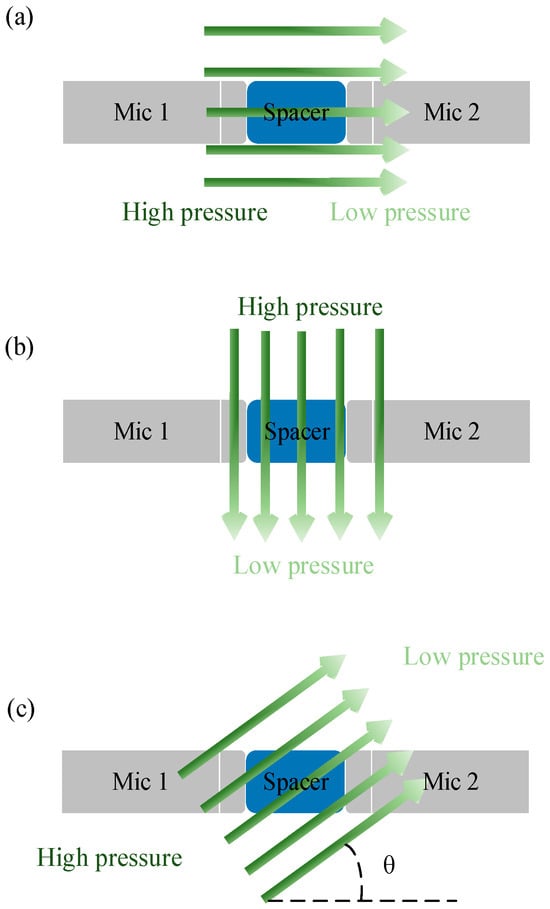
Figure 1.
Orientation of the intensity probe: (a) parallel to the sound field, (b) orthogonal to the sound field, (c) oriented at an angle relative to the sound field.
Being independent of the measurement distance, sound power provides consistent evaluations across different setups and accounts for the total acoustic energy radiated in all directions [19]. Consequently, the proposed approach effectively considers the effects of direction and distance on noise levels, while reducing the influence of environmental noise. There are two primary methods for measuring sound intensity and determining sound power level: the discrete-point technique, which complies with the ISO 9614-1 standard [20], and the scanning technique, based on the ISO 9614-2 standard [21]. The discrete-point approach is utilized for the measurements in this study due to its advantages, such as the capability of identifying sound source locations. To reduce the measurement time and avoid the need for moving the intensity probes during the measurements, multiple intensity probes are used at the same time [22].
The structure of the paper is as follows: Section 2 and Section 3 present the hardware and software configurations, respectively. Section 4 presents the sound power measurement results, followed by Section 5, which discusses the details of psychoacoustic metrics. Lastly, Section 6 provides the conclusions.
2. Hardware Setup
For sound pressure measurements, a single microphone is usually used, while sound intensity measurements require a pair of phase-matched microphones arranged face-to-face, forming an intensity probe. The probe’s working frequency range is determined by the spacer length between the two microphones. The spacer affects the probe’s ability to measure different frequencies. Shorter spacers enable the measurement of higher frequencies, while longer spacers are suited for lower frequencies. A 6 mm spacer is used in this study, allowing measurements across a frequency spectrum from 250 Hz to 10 kHz. To measure the sound intensity, twelve intensity probes are used, eliminating the need to move a single probe. To effectively cover the area around the motor, especially given the restricted access when the motor is coupled with a dynamometer, a half-cylindrical measurement surface is proposed. A specialized structure is designed and fabricated to securely arrange the intensity probes around the motor in this setup, as shown in Figure 2.
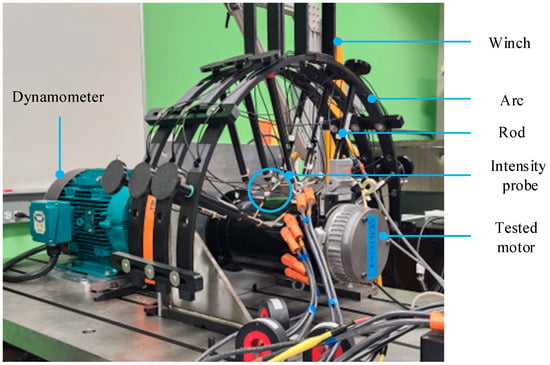
Figure 2.
Acoustic noise measurement fixture.
Based on the motor dimensions, the probes can be arranged around it in different settings, with different axial and circumferential spacings. The twelve probes can be arranged in either three rows of four probes or two rows of six probes each, spaced axially. To allow more flexibility in the axial spacing of the probes, three arcs are considered instead of one semi-cylinder, each with a diameter of 900 mm to fit larger motors.
To enhance the flexibility and ease of relocating the acoustic noise measurement setup, the fixture is mounted on a winch. The winch also allows for vertical adjustments of the fixture. Additionally, modifications have been made to the winch to support axial adjustments of the arcs. The fixture is built from aluminum extrusions and securely attached to the winch. The vertical rail incorporates linear bearings, with each arc connected to these bearings via a linking component.
Choosing a larger diameter for designed arcs can make testing smaller motors challenging, as intensity probes may be placed far from the tested motor. To tackle this problem, rods have been designed and fabricated, as shown in Figure 2. The axial length of the tested motor is 280 mm, and its outer diameter is 240 mm. Given these dimensions, measurements are conducted using three arcs, each equipped with four intensity probes. Once the probes are mounted, their radial distance (50 mm) is adjusted to bring them closer to the motor under test. Figure 2 illustrates the arrangement of the probes around the motor. A list of the equipment used for the acoustic noise measurements is provided in Table 1.

Table 1.
Equipment utilized for acoustic noise measurements.
3. Software Setup
To perform the measurements and process the resulting data, Simcenter Testlab software (version 2021.1) is used. Figure 3 illustrates the acoustic mesh created in the software for the tested motor. An acoustic mesh is an imaginary surface that surrounds the noise source and must be created for sound intensity measurements. The surface is subdivided into smaller sections, called mesh elements, with each measurement point or probe positioned at the center of a mesh element. The number of the mesh elements is the same as the number of the probes. To establish the acoustic mesh, the probe positions relative to the motor are measured, and the corner locations of the elements are then calculated. These calculated positions are utilized to establish the mesh.
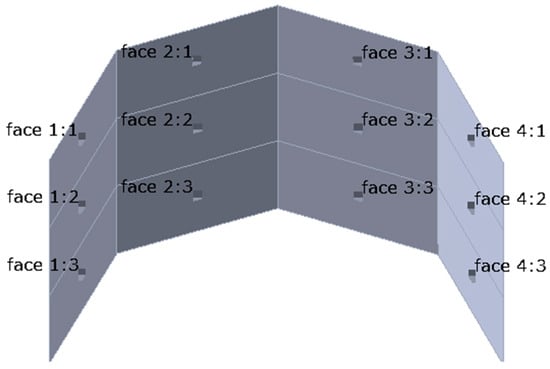
Figure 3.
Acoustic mesh established for the tested motor.
For setting up the microphones, the input channels are activated, and the microphone sensitivities are defined. Next, the probes are configured by combining two microphones into one probe. To accurately determine the direction of the measured sound intensity, microphone one should be designated as the microphone closer to the tested motor, while the other should be designated as microphone two. After configuring the probes, the spacer length, which in this case is 6 mm (as used during assembly), must be specified.
Some other measurement parameters need to be configured. The bandwidth is set to 25.6 kHz, exceeding twice the maximum frequency (10 kHz). The software averages multiple short-interval noise measurements to reduce the influence of background noise. The number of averages per second defines each measurement’s length, while the total measurement duration determines the overall series length. Longer durations help mitigate intermittent noise but may be unsuitable at peak loads. This study uses a 30 s total duration with individual measurements lasting 0.25 s (four averages per second), sufficient to capture the minimum frequency of 10 Hz (0.1 s period).
4. Sound Power Measurement
The acoustic noise of the tested SRM is characterized by evaluating the motor at different operating points, measuring sound pressure and sound intensity levels, and calculating sound power levels and psychoacoustic metrics. Table 2 shows the operating points selected for the measurements. The highest amount of the load torque depends on the speed, especially in the constant power region. The background noise in the no-load condition (e.g., 0 Nm) is also measured. The operating points are bounded by upper and lower limits, defined by the electrical and mechanical limitations of the setup. The experiments are conducted using pulse-width modulation (PWM) current control, operating at a switching frequency of 12.5 kHz. The industrial SRM is designed to deliver a continuous torque of 20 Nm and a maximum torque of 40 Nm at 80 V DC.

Table 2.
Operating points for the acoustic noise measurements of the tested motor.
Figure 4 illustrates the measured sound intensity at various operating points. Sound intensity is calculated at each measurement node by processing the sound pressure measured by the two microphones of each probe. The arrows indicate the direction of the measured noise at each point. Under the no-load condition (0 Nm), the direction of the arrows in some of the mesh elements points inward, indicating the dominance of environmental noise in those areas. Conversely, as shown in Figure 4b,d, motor noise becomes entirely dominant under load conditions.
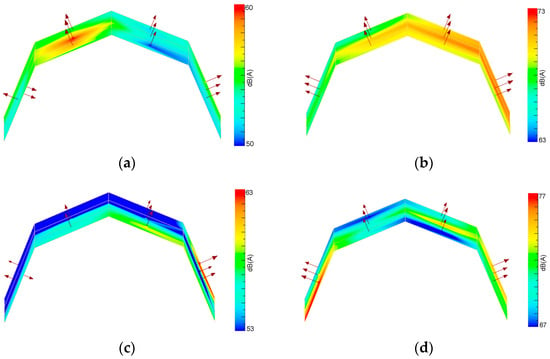
Figure 4.
Measured sound intensity at different operating points: (a) 600 rpm, 0 Nm; (b) 600 rpm, 30 Nm; (c) 1800 rpm, 0 Nm; (d) 1800 rpm, 20 Nm.
To evaluate sound intensity measurement quality, field indicators are computed for third-octave bands. Siemens Testlab derives four criteria—Crit. 0, Crit. 1a, Crit. 1b, and Crit. 2—from these indicators. Ideally, all criteria should be positive to comply with ISO 9614-1. Generally, the measurement quality is sufficient for sound power evaluation and motor performance assessment. Crit. 1a and Crit. 1b are usually positive, indicating minimal external noise due to soundproofing or probe placement. Crit. 0 is mostly positive but can drop to −5, while Crit. 2 is positive about half the time but may fall to −100, suggesting that more probes might be needed to meet standards.
Figure 5 shows the motor’s A-weighted acoustic power across various operating points. Due to the partial coverage of the acoustic mesh around the motor, these levels indicate its acoustic noise behavior rather than its precise sound power level. Due to the motor’s symmetrical design, the estimated sound power levels should closely approximate the actual behavior of the motor’s sound power level.
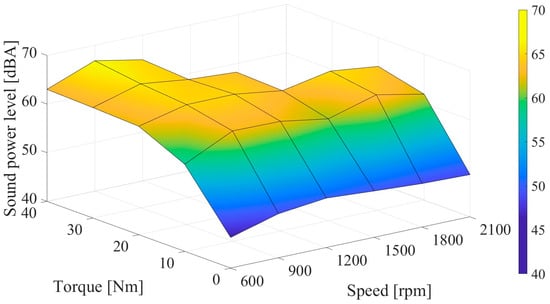
Figure 5.
Calculated sound power level at different operating points.
At each specific speed point, the motor’s sound power level generally increases with load. At lower load levels, the increase is pronounced; however, it becomes more gradual as the load reaches higher values. This trend can be explained by the more gradual increase in the amplitude of radial force harmonics at higher loads. It is also important to note that the sound power level does not always increase with loading. For instance, at 1200 RPM, it decreases from 64.68 dB to 64.27 dB as the torque increases from 20 Nm to 30 Nm.
Although an increase in speed generally leads to a higher sound power level at each specific speed point, there are exceptions. For example, at 30 Nm, the sound power level drops from 65.49 dB to 63.66 dB as the speed rises from 900 rpm to 1500 rpm. This decrease can be related to variations in the resonance behavior of the motor structure at different speeds, along with changes in the shape of the current waveform.
5. Psychoacoustic Metrics
To further investigate the acoustic noise characteristics of the tested motor, three psychoacoustic metrics are evaluated. The sound pressure measured by microphone two of probe five (face 2:2 in Figure 3) is used to calculate these metrics. The psychoacoustic metrics derived from additional microphones positioned around the motor’s entire circumferential area (e.g., faces 1:2, 3:2, 4:2 in Figure 3) produce comparable values.
5.1. Sharpness
Sharpness is the first metric analyzed and is affected by the high-frequency components of the acoustic noise spectrum. An increase in these high-frequency components leads to greater sharpness, whereas a decrease reduces it [23]. Figure 6 shows the sharpness curves over time for various speed and torque values. The corresponding mean sharpness values are summarized in Table 3. Figure 7 shows the mean sharpness as a function of speed for different load levels.
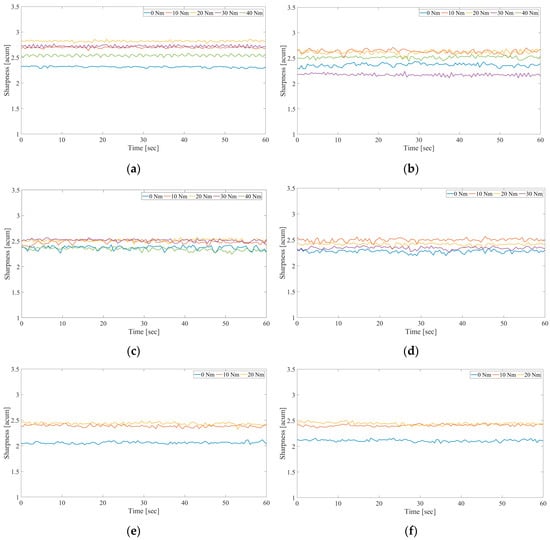
Figure 6.
Sound sharpness at different rotational speeds: (a) 600 rpm, (b) 900 rpm, (c) 1200 rpm, (d) 1500 rpm, (e) 1800 rpm, (f) 2100 rpm.

Table 3.
Average sound sharpness values (acum).
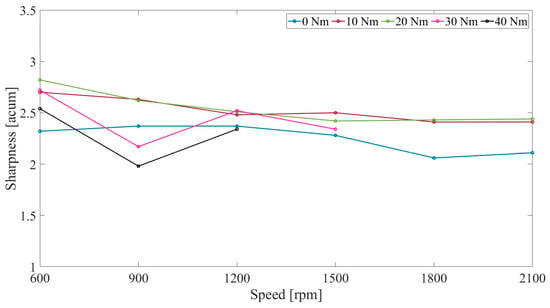
Figure 7.
Sound sharpness versus speed for different current references.
To better understand the measured values, according to [24], a sharpness value of 2.2 acum is measured for a bus 15 m from the midpoint of the lane. In [9], sharpness values of 3 acum and 3.3 acum are reported for an electric powertrain operating at 3000 rpm and 5000 rpm, respectively. In that case, the acoustic data was collected using an artificial head placed on the passenger seat.
In most cases, sharpness initially increases with load before eventually declining. At a given speed, as the load begins to rise, acoustic noise harmonics generally intensify, particularly at higher frequencies, primarily due to the effects of switching. With further load increase, dominant radial force harmonics continue to grow, contributing more noticeably to the overall noise level at lower frequencies. This behavior can be further analyzed using third-octave band plots. Figure 8 presents such plots for three different speed levels, each corresponding to three torque values.
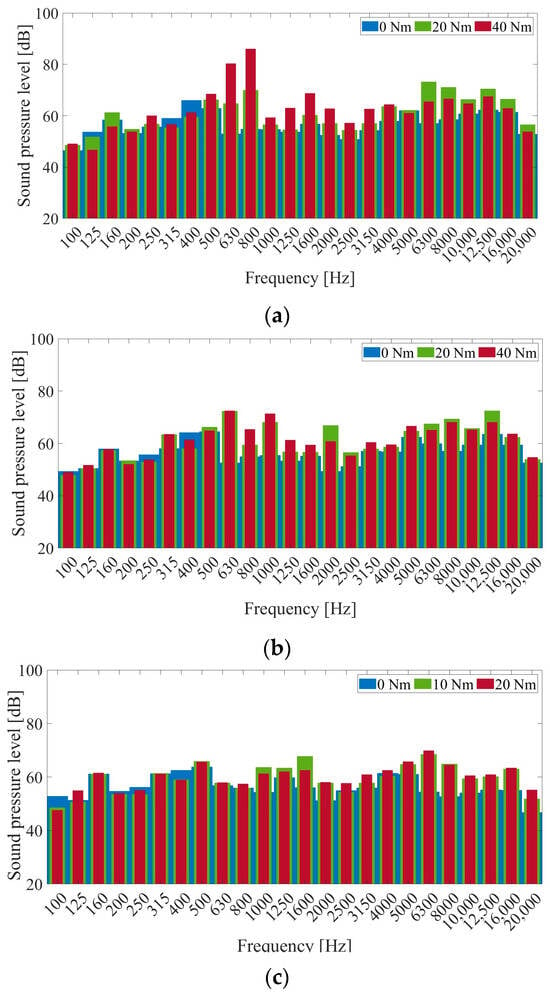
Figure 8.
Third-octave bands at different speeds: (a) 900 rpm, (b) 1200 rpm, (c) 1800 rpm.
At 900 rpm, as the torque increases from 0 Nm to 20 Nm, most octave bands exhibit higher levels, as shown in Figure 8a. This rise is especially prominent in the higher frequencies (6300 Hz, 8000 Hz, 10,000 Hz, 12,500 Hz, and 16,000 Hz bands), which results in a rise in sharpness from 2.37 acum at 0 Nm to 2.62 acum at 20 Nm. When the torque increases further from 20 Nm to 40 Nm, the levels of the low-frequency octave bands (630 Hz, 800 Hz, 1250 Hz, 1600 Hz, and 2000 Hz bands) increase, while the amplitude in the higher frequencies (6300 Hz, 8000 Hz, 10,000 Hz, 12,500 Hz, 16,000 Hz, and 20,000 Hz bands) decreases. As a result, sharpness drops from 2.62 acum at 20 Nm to 1.98 acum at 40 Nm.
At 1200 rpm, as illustrated in Figure 8b, as the torque increases from 0 Nm to 20 Nm, the magnitude of most octave bands increases. For the octave bands with center frequencies lower than 5000 Hz, the magnitude of some bands increases while the magnitude of others decreases. However, in the high-frequency region (6300 Hz, 8000 Hz, 10,000 Hz, 12,500 Hz, and 16,000 Hz bands), the magnitude of all bands increases, which increases the sharpness from 2.37 acum at 0 Nm to 2.51 acum at 20 Nm. As the torque increases from 20 Nm to 40 Nm, the levels of the low-frequency octave bands (those with center frequencies less than 5000 Hz) either remain stable or increase, while they generally decrease in the higher frequencies (6300 Hz, 8000 Hz, and 12,500 Hz bands). As a result, the sharpness value drops from 2.51 acum at 20 Nm to 2.34 acum at 40 Nm.
At 1800 rpm, sharpness increases when the torque increases from zero to 10 Nm. As depicted in Figure 8c, this change in load primarily increases the magnitude of the octaves in the higher-frequency region (octave bands with center frequencies larger than 6300 Hz), explaining the higher value of sharpness of 2.41 acum. When the torque is subsequently increased from 10 Nm to 20 Nm, the magnitude of most octave bands remains unchanged. However, the levels of low-frequency octave bands, with center frequencies of 1000, 1250, and 1600 Hz, decrease. Accordingly, sharpness increases slightly with this transition from 2.41 acum to 2.44 acum.
When comparing sharpness values at different speeds for the same load level (Figure 7), various factors must be considered. One important factor is the influence of the switching frequency. In the experiments conducted in this study, the switching frequency is set to 12.5 kHz. At speeds higher than the base speed, the current control changes to a single pulse control, and the controller adjusts the position of the pulses based on motor speed. In single pulse mode, the switching occurs at the fundamental electrical frequency rather than at the switching frequency. Other factors influencing the sharpness at different speeds include the varying amplitudes of the acoustic noise octave bands and the different amplitudes of resonance.
Figure 9 illustrates the phase current waveforms at speeds of 600 rpm, 900 rpm, 1500 rpm, and 2100 rpm, all under a load torque of 20 Nm. It can be observed that at 600 rpm, 1200 rpm, and 1800 rpm, the peak values and shapes of the currents are modulated by the switching. Although the switching frequency remains the same in these three cases, its effect on the motor’s noise level reduces as speed increases.
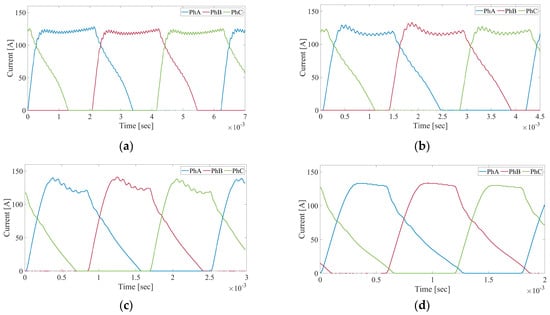
Figure 9.
Phase current waveforms for 20 Nm load and different speeds: (a) 600 rpm, (b) 900 rpm, (c) 1500 rpm, (d) 2100 rpm.
Figure 10 shows the third octave bands for a load torque of 20 Nm and speeds of 600 rpm, 900 rpm, 1500 rpm, and 2100 rpm. As the speed increases, the amplitude of the octave band centered at 12,500 Hz (switching frequency) and its two adjacent octave bands (centered at 10,000 Hz and 16,000 Hz) decreases. As a result, the sharpness drops from 2.82 acum at 600 rpm to 2.62 acum at 900 rpm and then to 2.42 acum at 1800 rpm.
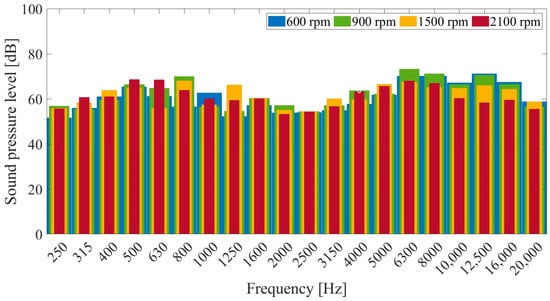
Figure 10.
Third-octave bands at 20 Nm load and different speeds.
At 2100 rpm, switching is not applied, and the current waveform is shaped by adjusting the position of the excitation pulses relative to the rotor position. At this speed, the fundamental frequency is 560 Hz, and the switching occurs at this frequency. Comparing the third octave bands at 1500 rpm and 2100 rpm (Figure 10) shows a sharp decrease in the amplitude of the band centered at 12,500 Hz and its adjacent bands (10,000 Hz and 16,000 Hz), while the amplitudes of the bands centered at 500 Hz and 630 Hz increase significantly due to the change in switching frequency from 12.5 kHz to 560 Hz. As the speed increases from 1500 rpm to 2100 rpm, the sharpness increases slightly from 2.42 acum to 2.44 acum, as changes in the amplitudes of other octave bands offset the reduction caused by the change in switching frequency.
5.2. Loudness
The second analyzed metric is loudness, which exhibits behavior comparable to the measured sound power level. Unlike decibels, which are derived from mathematical calculations, loudness is determined by human perception and reflects how sound is subjectively experienced [25]. Loudness can be quantified using units such as sones or phons, both of which measure loudness levels. A phon is a unit representing the perceived loudness equal to that of a 1000 Hz tone. For instance, if a tone is measured at 90 phon, it is perceived as equally loud as a 1000 Hz tone at 90 dB. Similarly, if a 125 Hz tone registers at 47 phon, it is perceived as equally loud to a 1000 Hz tone at 47 dB [25]. The sone is another unit for expressing equal loudness. The conversion between phons and sones can be defined as follows [25]:
Sone is usually favored over phon as it follows a linear scale. This means that when the sone value triples, the perceived loudness also triples, and this consistency holds across all frequencies. Figure 11 shows the loudness curves versus time for various speed and torque values. The corresponding mean loudness values are summarized in Table 4, and Figure 12 shows the mean loudness as a function of speed for different load levels.
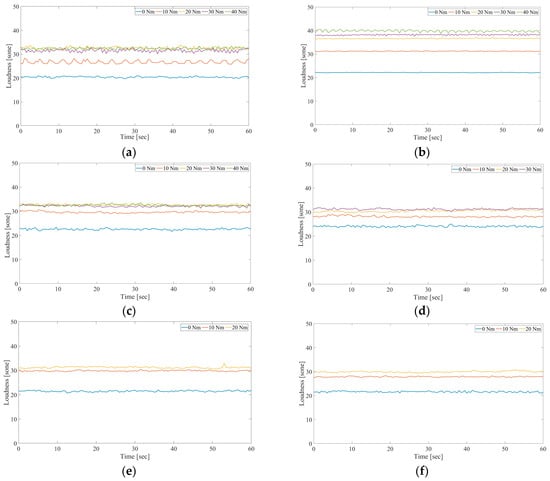
Figure 11.
Sound loudness at different rotational speeds: (a) 600 rpm, (b) 900 rpm, (c) 1200 rpm, (d) 1500 rpm, (e) 1800 rpm, (f) 2100 rpm.

Table 4.
Average sound loudness values (sone).
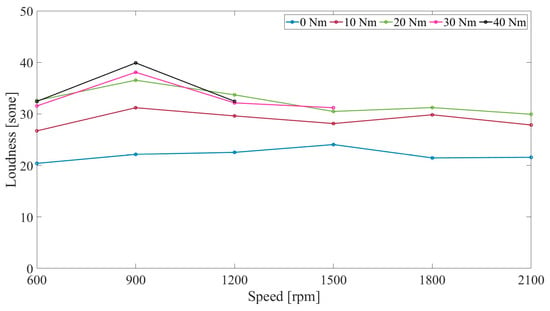
Figure 12.
Sound loudness versus speed for different current references.
The trend in loudness curves at different speeds aligns with the results of the sound power level calculations, except for one instance at the 600 rpm speed point, where transitioning from 20 Nm to 30 Nm results in a decrease in loudness with the load. Similar to the sound power characteristics, the rate of increase in loudness is higher at lighter load, but it diminishes as the load torque increases. The peak loudness value is 39.9 sone and it occurs at 900 rpm with 40 Nm load torque. This coincides with the maximum calculated sound power level of 66.79 dB at the same operating point. When comparing operating points with the same torque value but different speeds (Figure 12), it becomes evident that the behavior of loudness is not uniform. To better understand the measured values, 32 sone correspond to a 90 dB noise at 1 kHz or an 80 dB noise at 4 kHz. According to [22], this is comparable to the noise level of a bus measured 15 m from the midpoint of the lane. In [9], loudness values of 25 sone and 30 sone are reported for an electric powertrain at 3000 rpm and 5000 rpm, respectively. In that case, the acoustic data was collected using an artificial head placed on the passenger seat.
5.3. Roughness
The third analyzed metric is roughness, which measures the extent of modulation within a sound, evaluating both frequency and amplitude modulations. Higher roughness values indicate greater perceptibility of modulation [26]. Figure 13 illustrates the roughness curves versus time for various speed points and loads. The corresponding mean roughness values are summarized in Table 5, and Figure 14 shows the mean roughness as a function of speed for different load levels.
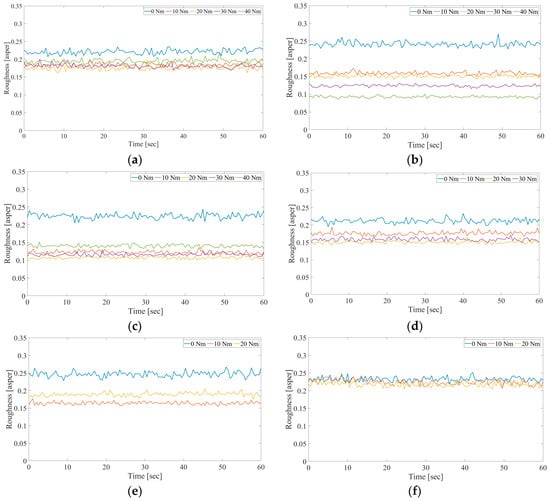
Figure 13.
Sound roughness at different rotational speeds: (a) 600 rpm, (b) 900 rpm, (c) 1200 rpm, (d) 1500 rpm, (e) 1800 rpm, (f) 2100 rpm.

Table 5.
Average sound roughness values (asper).
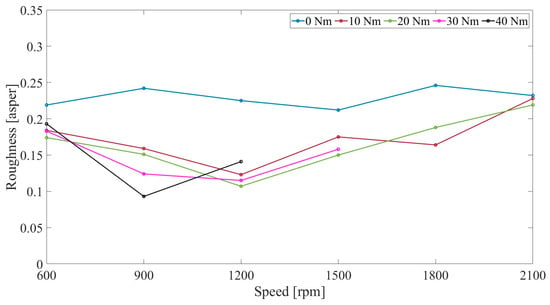
Figure 14.
Sound roughness versus speed for different current references.
According to [22], an average roughness value of 2.76 asper is measured for a bus 15 m from the midpoint of the lane. In [9], roughness values of 2.5 asper and 3 asper are reported for an electric powertrain at 3000 rpm and 5000 rpm, respectively. The measured roughness values in this study are much lower than these values. One reason is the lower number of components contributing to acoustic noise generation in our experiments. A bus or a powertrain includes many different components (e.g., engine, electric motor, gearbox, etc.), and the noise from these components can interfere with each other, increasing the amplitude and frequency modulations.
In most cases, roughness decreases with increasing load; however, in some instances, it increases again after reaching a minimum. This indicates that loading the motor generally reduces the extent of amplitude and frequency modulations. In certain cases, the degree of amplitude modulation can be evaluated using time-domain sound pressure measurements. However, this is not always straightforward, as the frequency at which the modulation occurs is also significant. It should also be noted that environmental noise (e.g., the noise from the dynamometer used in these experiments) can impact the measured roughness values.
6. Conclusions
This paper investigates the acoustic noise characteristics of an industrial switched reluctance motor. A multi-probe sound intensity measurement method is introduced to improve the accuracy of sound power calculations. The motor is tested at various operating points with pulse-width modulation current control. The effects of speed and load variations on various aspects of the motor’s acoustic noise are examined. The maximum sound power levels measured at continuous load (20 Nm) and peak load (40 Nm) are 65.21 dB and 66.79 dB, respectively. The calculated loudness at continuous load peaks at 900 rpm with 36.54 sone but declines afterward to 31.22 sone and 29.93 sone at 1800 rpm and 2100 rpm, respectively. Furthermore, the sharpness of the noise generally increases with load up to a certain point and then mostly decreases. For example, at 900 rpm, as the load increases from 0 to 20 Nm, the magnitude of most octave bands rises, especially in the high-frequency range, leading to an increase in sharpness from 2.37 acum to 2.62 acum. As the load increases further from 20 Nm to 40 Nm, the amplitude of the octave bands grows in the lower frequencies while declining in the higher frequencies. As a result, sharpness decreases from 2.62 acum at 20 Nm to 1.98 acum at 40 Nm. Roughness typically decreases with increasing load; however, in some instances, it increases again after reaching a minimum. This suggests that loading the motor generally reduces the extent of amplitude and frequency modulations. The psychoacoustic metrics offer important information about the quality of the motor’s acoustic noise across various operating conditions. These insights can be applied during the control stage of the design process to develop a product that not only meets the required standards but also produces acoustically acceptable noise.
Author Contributions
Conceptualization, M.M. and B.B.; Methodology, M.M.; Investigation, M.M.; Writing—original draft preparation, M.M.; Writing—review and editing, B.B. All authors have read and agreed to the published version of the manuscript.
Funding
This research received no external funding.
Data Availability Statement
Data are contained within the article.
Acknowledgments
This research was undertaken, in part, thanks to funding from the Natural Sciences and Engineering Council of Canada (NSERC) and the Canada Foundation for Innovation (CFI). The authors would like to thank GRAS and Siemens for their support with experimental acoustic noise measurement instruments and Siemens Testlab software in this research.
Conflicts of Interest
The authors declare no conflicts of interest.
References
- Masoumi, M.; Bilgin, B. Comparative study on the radial force and acoustic noise harmonics of an interior permanent magnet, induction, and switched reluctance motor drive. IEEE Access 2024, 12, 49937–49946. [Google Scholar] [CrossRef]
- Rahmani, M.; Darabi, A.; Deylami, F.P. Impact of the stator coil pitch on acoustic noise and vibration of squirrel cage induction motors. IEEE Trans. Energy Convers. 2023, 38, 2344–2352. [Google Scholar] [CrossRef]
- Masoumi, M.; Tsao, A.; Abeyrathne, C.; Sahu, A.; Bilgin, B. Investigation of the impact of rotor shaping on the torque and radial force harmonics of a V-shape interior permanent magnet synchronous machine. IET Electr. Power Appl. 2024, 18, 185–194. [Google Scholar] [CrossRef]
- Liang, J.; Howey, B.; Bilgin, B.; Emadi, A. Source of acoustic noise in a 12/16 external-rotor switched reluctance motor: Stator tangential vibration and rotor radial vibration. IEEE Open J. Ind. Appl. 2020, 1, 63–73. [Google Scholar] [CrossRef]
- Ibrahim, I.; Rahman, T.; Lowther, D.A. A study of vibroacoustic performance of synchronous motor drives under different operating conditions. In Proceedings of the International Electric Machines & Drives Conference (IEMDC), Hartford, CT, USA, 16–19 May 2021; pp. 1–9. [Google Scholar]
- Gonzalez, P.; Buigues, G.; Mazon, A.J. Noise in electric motors: A comprehensive review. Energies 2023, 16, 5311. [Google Scholar] [CrossRef]
- Zhu, M.; Hu, W.; Kar, N.C. Acoustic noise-based uniform permanent-magnet demagnetization detection in SPMSM for high-performance PMSM drive. IEEE Trans. Transport. Electr. 2018, 4, 303–313. [Google Scholar] [CrossRef]
- Qian, Z.; Qi, L.; Li, G.; Deng, W.; Sun, Z.; Chen, Q. Analysis of vibration and noise in electric drive system under resolver and motor rotor coupling eccentricity. IEEE Trans. Transport. Electr. 2024, 10, 1827–1836. [Google Scholar] [CrossRef]
- Fang, Y.; Zhang, T. Sound quality of the acoustic noise radiated by PWM-fed electric powertrain. IEEE Trans. Ind. Electron. 2018, 65, 4534–4541. [Google Scholar] [CrossRef]
- Andersson, A.; Lennström, D.; Nykänen, A. Influence of inverter modulation strategy on electric drive efficiency and perceived sound quality. IEEE Trans. Transp. Electrific. 2016, 2, 24–35. [Google Scholar] [CrossRef]
- Pindoriya, R.M.; Thakur, R.K.; Rajpurohit, B.S.; Kumar, R. Numerical and experimental analysis of torsional vibration and acoustic noise of PMSM coupled with DC generator. IEEE Trans. Ind. Electron. 2022, 69, 3345–3356. [Google Scholar] [CrossRef]
- Imakawa, T.; Chimata, K.; Hoshi, N.; Chiba, A.; Takemoto, M.; Ogasawara, S. Characteristic measurements of switched reluctance motor on prototype electric vehicle. In Proceedings of the IEEE International Electric Vehicle Conference, Greenville, SC, USA, 4–8 March 2012. [Google Scholar]
- Furqani, J.; Wiguna, C.A.; Chiba, A.; Gundogmus, O.; Sozer, Y.; Purwadi, A. Experimental verification of acoustic noise and radial force sum variation in switched reluctance motor. IEEE Trans. Ind. Appl. 2021, 57, 2481–2493. [Google Scholar] [CrossRef]
- Wiguna, C.A.; Cai, Y.; Lilian, L.L.S.S.; Furqani, J.; Fujii, Y.; Kiyota, K.; Chiba, A. Vibration and acoustic noise reduction in switched reluctance motor by selective radial force harmonics reduction. IEEE Open J. Ind. Appl. 2022, 4, 23–34. [Google Scholar] [CrossRef]
- Feng, S.; Qu, R. Noise and vibration analysis of integrated two-speed e-powertrain system for electric vehicles. IEEE Trans. Ind. Appl. 2024, 60, 57–67. [Google Scholar] [CrossRef]
- Liang, J.; Li, Y.; Mak, C.; Bilgin, B.; Al-Ani, D.; Emadi, A. A comprehensive analysis of the acoustic noise in an interior permanent magnet traction motor. In Proceedings of the Energy Conversion Congress and Exposition (ECCE), Baltimore, MD, USA, 29 September–3 October 2019. [Google Scholar]
- DEWESoft. Sound Power Measurement. Available online: https://dewesoft.com/applications/sound-power/ (accessed on 14 March 2025).
- SIEMENS Community. Sound Intensity. Available online: https://community.sw.siemens.com/s/article/Sound-Intensity (accessed on 14 March 2025).
- Sound Pressure, Sound Power, and Sound Intensity: What’s the Difference? Available online: https://community.sw.siemens.com/s/article/sound-pressure-sound-power-and-sound-intensity-what-s-the-difference/ (accessed on 14 March 2025).
- ISO 9614-1:1993; Acoustics—Determination of Sound Power Levels of Noise Sources Using Sound Intensity—Part 1: Measurement at Discrete Points. ISO: Geneva, Switzerland, 1993.
- ISO 9614-2:1996; Acoustics—Determination of Sound Power Levels of Noise Sources Using Sound Intensity—Part 2: Measurement by Scanning. ISO: Geneva, Switzerland, 1996.
- SIEMENS Community. Simcenter Testlab: Measuring Sound Intensity. Available online: https://community.sw.siemens.com/s/article/Simcenter-Testlab-Measuring-Sound-Intensity/ (accessed on 14 March 2025).
- SIEMENS Community. Sharpness in Simcenter Testlab. Available online: https://community.sw.siemens.com/s/article/Sharpness-in-Simcenter-Testlab/ (accessed on 14 March 2025).
- Kaczmarek, T.; Hafke, H.; Preis, A.; Sandrock, S.; Griefahn, B.; Gjestland, T. The Tram Bonus. Arch. Acoust. 2006, 31, 405–412. [Google Scholar]
- SIEMENS Community. Sound Quality Metrics: Loudness and Sones. Available online: https://community.sw.siemens.com/s/article/sound-quality-metrics-loudness-and-sones (accessed on 14 March 2025).
- SIEMENS Community. Sound Modulation Metrics: Fluctuation Strength and Roughness. Available online: https://community.sw.siemens.com/s/article/sound-modulation-metrics-fluctuation-strength-and-roughness/ (accessed on 14 March 2025).
Disclaimer/Publisher’s Note: The statements, opinions and data contained in all publications are solely those of the individual author(s) and contributor(s) and not of MDPI and/or the editor(s). MDPI and/or the editor(s) disclaim responsibility for any injury to people or property resulting from any ideas, methods, instructions or products referred to in the content. |
© 2025 by the authors. Licensee MDPI, Basel, Switzerland. This article is an open access article distributed under the terms and conditions of the Creative Commons Attribution (CC BY) license (https://creativecommons.org/licenses/by/4.0/).